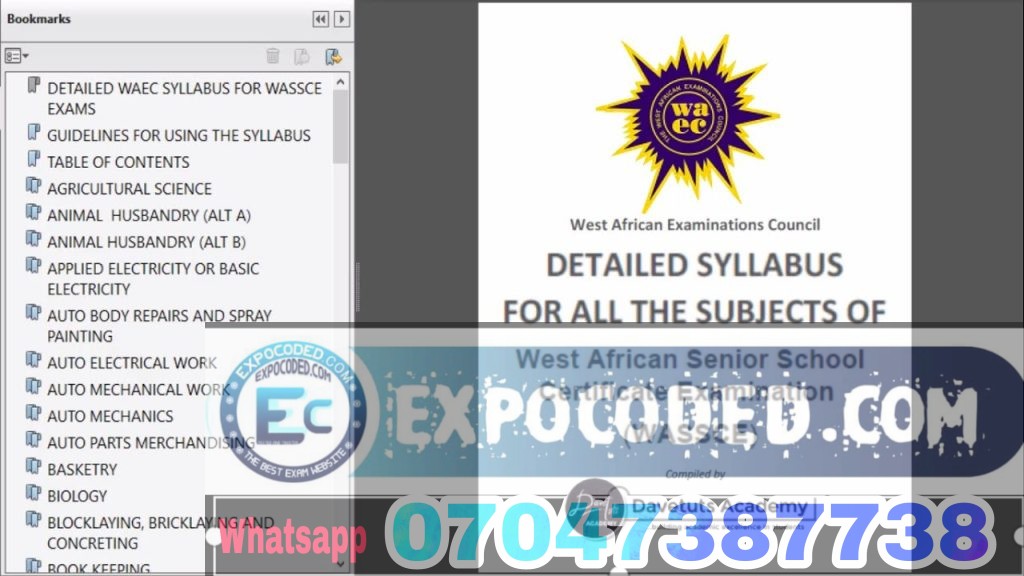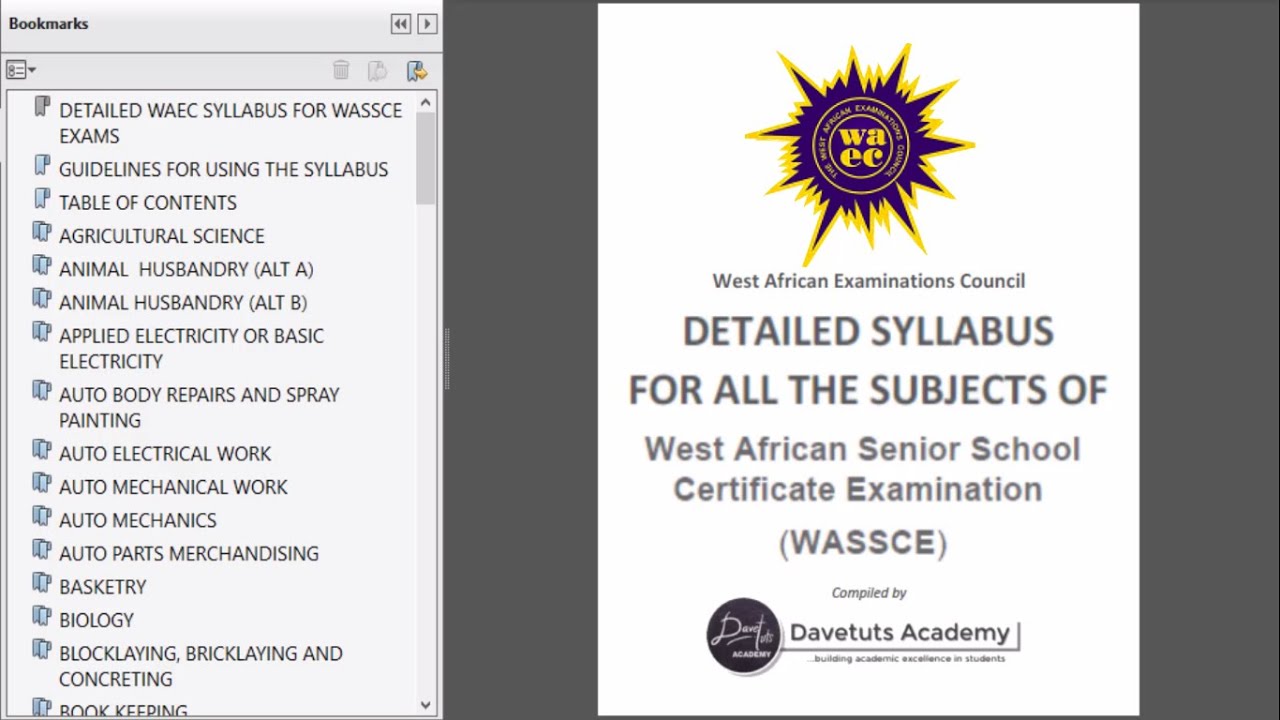WAEC Syllabus for Further Mathematics 2024/2025
Are you preparing for the West African Examination Council (WAEC) Further Mathematics exam? Do you want to know the aims and objectives, topics, and recommended textbooks for the exam? If yes, then you are in the right place. In this blog post, I will share with you everything you need to know about the WAEC Syllabus for Further Mathematics 2024/2025.

What is Further Mathematics?
Further Mathematics is an advanced level of Mathematics that covers topics beyond the General Mathematics/Mathematics (Core) syllabus. It is designed for students who have a strong interest and aptitude in Mathematics and who wish to pursue higher studies or careers in Mathematics, Engineering, Science, and other related fields.
Why Study Further Mathematics?
Studying Further Mathematics has many benefits, such as:
- It develops your conceptual and manipulative skills in Mathematics
- It bridges the gap between Elementary Mathematics and Higher Mathematics
- It exposes you to aspects of Mathematics that are relevant and applicable to various disciplines and professions
- It enhances your ability to analyze data and draw valid conclusions
- It fosters your logical, abstract, and precise reasoning skills
What are the Aims and Objectives of the WAEC Further Mathematics Syllabus?
The WAEC Further Mathematics Syllabus is a document that outlines the scope and content of the Further Mathematics exam. It also specifies the learning outcomes and assessment criteria for the exam. The aims and objectives of the syllabus are to test candidates’ development of:
- Further conceptual and manipulative skills in Mathematics
- Understanding of an intermediate course of study that bridges the gap between Elementary Mathematics and Higher Mathematics
- Acquisition of aspects of Mathematics that can meet the needs of potential Mathematicians, Engineers, Scientists, and other professionals
- Ability to analyze data and draw valid conclusions
- Logical, abstract, and precise reasoning skills
What is the Examination Scheme of the WAEC Further Mathematics Exam?
The WAEC Further Mathematics Exam consists of two papers, Papers 1 and 2, both of which must be taken. The examination scheme is as follows:
- Paper 1: This paper consists of 40 multiple-choice objective questions, covering the entire syllabus. Candidates are required to answer all questions in 1 hour for 40 marks. The questions are drawn from the sections of the syllabus as follows:
- Pure Mathematics – 30 questions
- Statistics and Probability – 4 questions
- Vectors and Mechanics – 6 questions
- Paper 2: This paper consists of two sections, Sections A and B, to be answered in 2 hours for 100 marks. Section A consists of eight compulsory questions that are elementary in type for 48 marks. The questions are distributed as follows:
- Pure Mathematics – 4 questions
- Statistics and Probability – 2 questions
- Vectors and Mechanics – 2 questions
Section B consists of seven questions of greater length and difficulty put into three parts: Parts I, II, and III as follows:
- Part I: Pure Mathematics – 3 questions
- Part II: Statistics and Probability – 2 questions
- Part III: Vectors and Mechanics – 2 questions
Candidates are required to answer four questions with at least one from each part for 52 marks.
What are the Topics in the WAEC Further Mathematics Syllabus?
The WAEC Further Mathematics Syllabus covers topics in Pure Mathematics, Statistics and Probability, Vectors and Mechanics. The topics are as follows:
Pure Mathematics
- Sets
- Surds
- Binary Operations
- Logical Reasoning
- Functions
- Polynomial Functions
- Indices and Logarithmic Functions
- Exponential and Circular Functions
- Complex Numbers
- Matrices and Determinants
- Sequences and Series
- Permutations and Combinations
- Binomial Theorem
- Mathematical Induction
- Differentiation
- Integration
- Differential Equations
- Coordinate Geometry
- Trigonometry
- Inequalities
- Linear Programming
- Numerical Methods
Statistics and Probability
- Data Presentation and Analysis
- Measures of Location and Dispersion
- Probability
- Probability Distributions
- Sampling and Estimation
- Hypothesis Testing
- Correlation and Regression
- Index Numbers
- Time Series
Vectors and Mechanics
- Vectors in Two and Three Dimensions
- Scalar and Vector Products
- Kinematics of a Particle
- Dynamics of a Particle
- Statics of a Particle
- Work, Energy, and Power
- Impulse and Momentum
- Rigid Bodies
- Circular Motion
- Simple Harmonic Motion
What are the Recommended Textbooks for the WAEC Further Mathematics Exam?
The WAEC Further Mathematics Syllabus recommends the following textbooks for candidates preparing for the exam:
- New General Mathematics for Senior Secondary Schools 3 by M.F. Macrae et al. (Pearson Education, 2008)
- Further Mathematics Project Books 1 to 3 by Tuttuh-Adegun et al. (Pearson Education, 2014)
- A Textbook of West African Advanced Mathematics by O.A. Bamisaye et al. (Evans Brothers, 2006)
- Advanced Level Mathematics: Pure Mathematics 1 by Hugh Neill and Douglas Quadling (Cambridge University Press, 2002)
- Advanced Level Mathematics: Pure Mathematics 2 & 3 by Hugh Neill and Douglas Quadling (Cambridge University Press, 2002)
- Advanced Level Mathematics: Statistics 1 by Steve Dobbs and Jane Miller (Cambridge University Press, 2002)
- Advanced Level Mathematics: Statistics 2 by Steve Dobbs and Jane Miller (Cambridge University Press, 2002)
- Advanced Level Mathematics: Mechanics 1 by Douglas Quadling (Cambridge University Press, 2002)
- Advanced Level Mathematics: Mechanics 2 by Douglas Quadling (Cambridge University Press, 2002)
Conclusion
In this blog post, I have given you an overview of the WAEC Syllabus for Further Mathematics 2024/2025. I hope you have learned something useful and interesting from it. If you have any questions or comments, please feel free to leave them below. I wish you all the best in your WAEC Further Mathematics exam. ?
Summary
- Further Mathematics is an advanced level of Mathematics that covers topics beyond the General Mathematics/Mathematics (Core) syllabus.
- The WAEC Further Mathematics Syllabus aims to test candidates’ development of further conceptual and manipulative skills in Mathematics, understanding of an intermediate course of study that bridges the gap between Elementary Mathematics and Higher Mathematics, acquisition of aspects of Mathematics that can meet the needs of potential Mathematicians, Engineers, Scientists, and other professionals, ability to analyze data and draw valid conclusions, and logical, abstract, and precise reasoning skills.
- The WAEC Further Mathematics Exam consists of two papers, Papers 1 and 2, both of which must be taken. Paper 1 consists of 40 multiple-choice objective questions, covering the entire syllabus. Paper 2 consists of two sections, Sections A and B, to be answered in 2 hours. Section A consists of eight compulsory questions that are elementary in type. Section B consists of seven questions of greater length and difficulty put into three parts: Parts I, II, and III.
- The WAEC Further Mathematics Syllabus covers topics in Pure Mathematics, Statistics and Probability, Vectors and Mechanics.
- The WAEC Further Mathematics Syllabus recommends the following textbooks for candidates preparing for the exam: New General Mathematics for Senior Secondary Schools 3 by M.F. Macrae et al., Further Mathematics Project Books 1 to 3 by Tuttuh-Adegun et al., A Textbook of West African Advanced Mathematics by O.A. Bamisaye et al., Advanced Level Mathematics: Pure Mathematics 1 by Hugh Neill and Douglas Quadling, Advanced Level Mathematics: Pure Mathematics 2 & 3 by Hugh Neill and Douglas Quadling, Advanced Level Mathematics: Statistics 1 by Steve Dobbs and Jane Miller, Advanced Level Mathematics: Statistics 2 by Steve Dobbs and Jane Miller, Advanced Level Mathematics: Mechanics 1 by Douglas Quadling, and Advanced Level Mathematics: Mechanics 2 by Douglas Quadling.
Frequently Asked Questions and Answers
- Q: What is the difference between General Mathematics and Further Mathematics?
- A: General Mathematics is the basic level of Mathematics that covers topics such as Number and Numeration, Algebra, Geometry and Mensuration, Trigonometry, Calculus, and Statistics. Further Mathematics is the advanced level of Mathematics that covers topics such as Sets, Surds, Binary Operations, Logical Reasoning, Functions, Polynomial Functions, Indices and Logarithmic Functions, Exponential and Circular Functions, Complex Numbers, Matrices and Determinants, Sequences and Series, Permutations and Combinations, Binomial Theorem, Mathematical Induction, Differentiation, Integration, Differential Equations, Coordinate Geometry, Trigonometry, Inequalities, Linear Programming, Numerical Methods, Data Presentation and Analysis, Measures of Location and Dispersion, Probability, Probability Distributions, Sampling and Estimation, Hypothesis Testing, Correlation and Regression, Index Numbers, Time Series, Vectors in Two and Three Dimensions, Scalar and Vector Products, Kinematics of a Particle, Dynamics of a Particle, Statics of a Particle, Work, Energy, and Power, Impulse and Momentum, Rigid Bodies, Circula
